Journal of Clinical & Diagnostic Research
VerifiedAdded on 2022/08/26
|12
|2349
|19
AI Summary
Contribute Materials
Your contribution can guide someone’s learning journey. Share your
documents today.
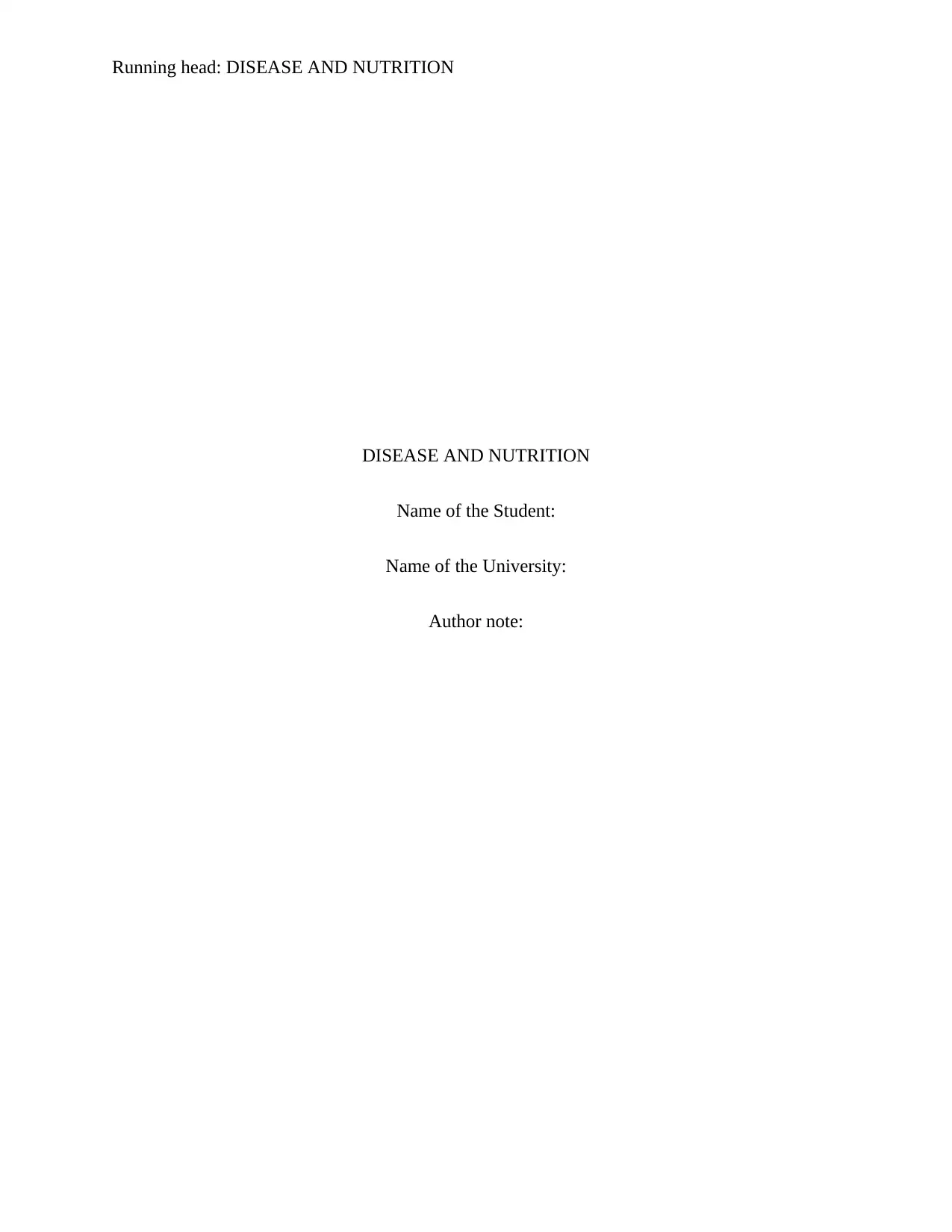
Running head: DISEASE AND NUTRITION
DISEASE AND NUTRITION
Name of the Student:
Name of the University:
Author note:
DISEASE AND NUTRITION
Name of the Student:
Name of the University:
Author note:
Secure Best Marks with AI Grader
Need help grading? Try our AI Grader for instant feedback on your assignments.
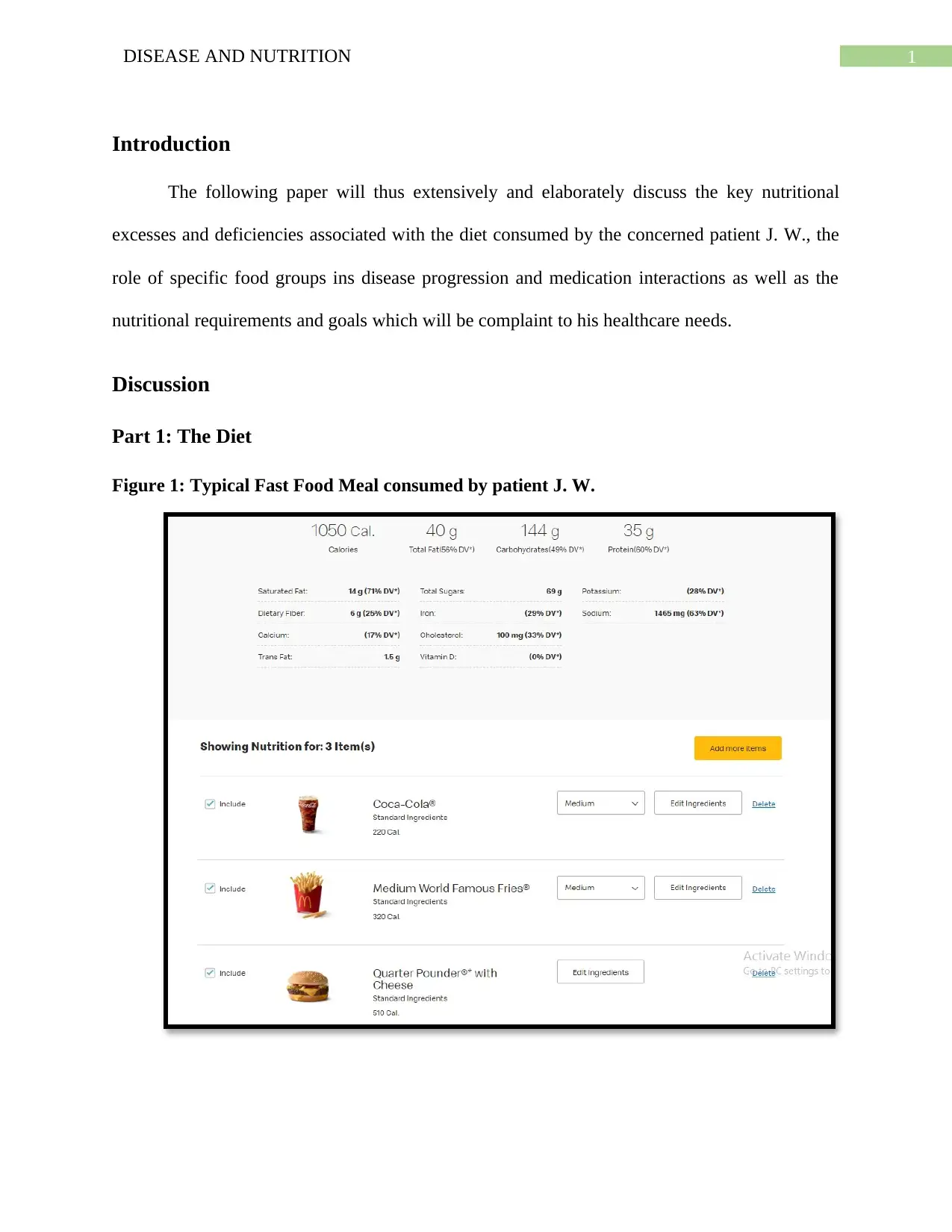
1DISEASE AND NUTRITION
Introduction
The following paper will thus extensively and elaborately discuss the key nutritional
excesses and deficiencies associated with the diet consumed by the concerned patient J. W., the
role of specific food groups ins disease progression and medication interactions as well as the
nutritional requirements and goals which will be complaint to his healthcare needs.
Discussion
Part 1: The Diet
Figure 1: Typical Fast Food Meal consumed by patient J. W.
Introduction
The following paper will thus extensively and elaborately discuss the key nutritional
excesses and deficiencies associated with the diet consumed by the concerned patient J. W., the
role of specific food groups ins disease progression and medication interactions as well as the
nutritional requirements and goals which will be complaint to his healthcare needs.
Discussion
Part 1: The Diet
Figure 1: Typical Fast Food Meal consumed by patient J. W.
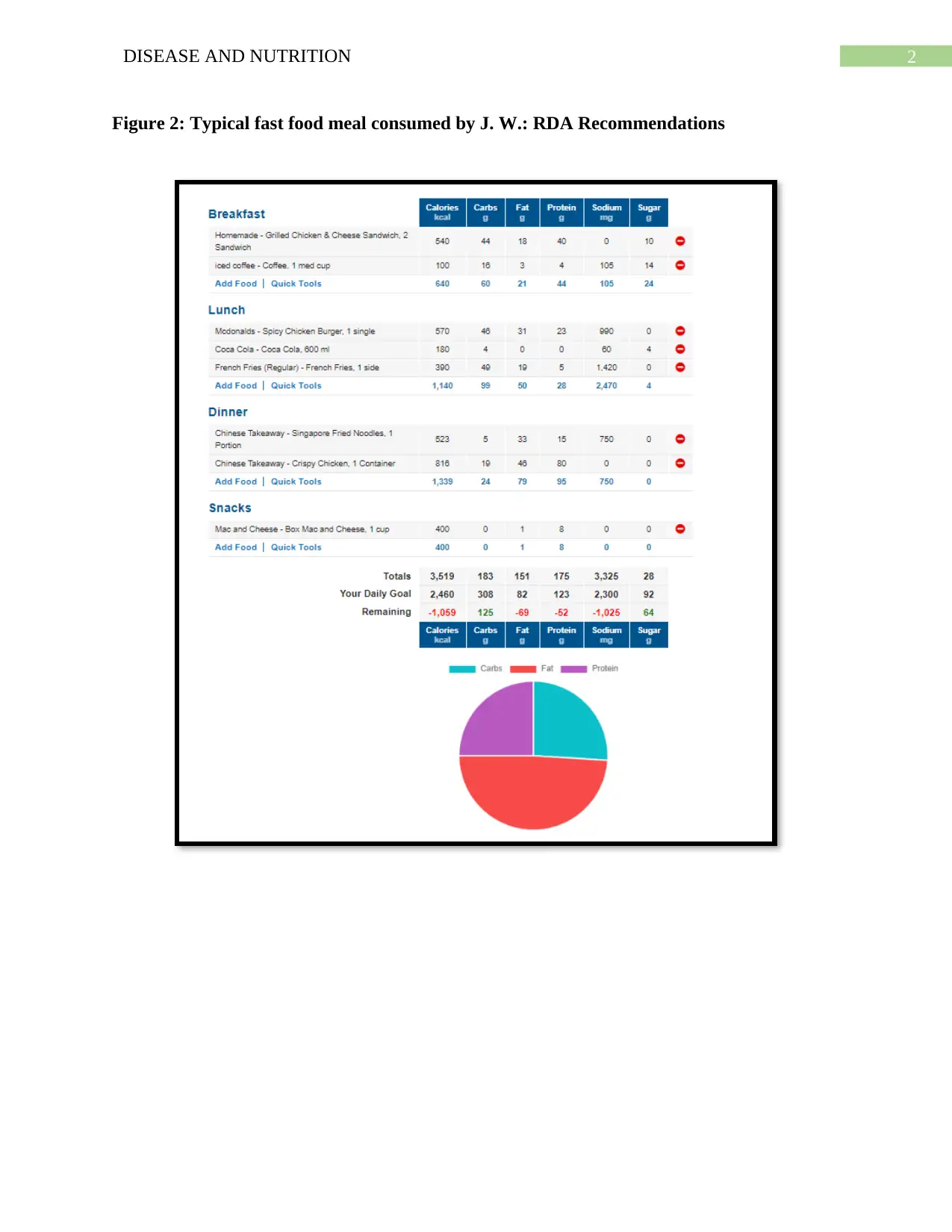
2DISEASE AND NUTRITION
Figure 2: Typical fast food meal consumed by J. W.: RDA Recommendations
Figure 2: Typical fast food meal consumed by J. W.: RDA Recommendations
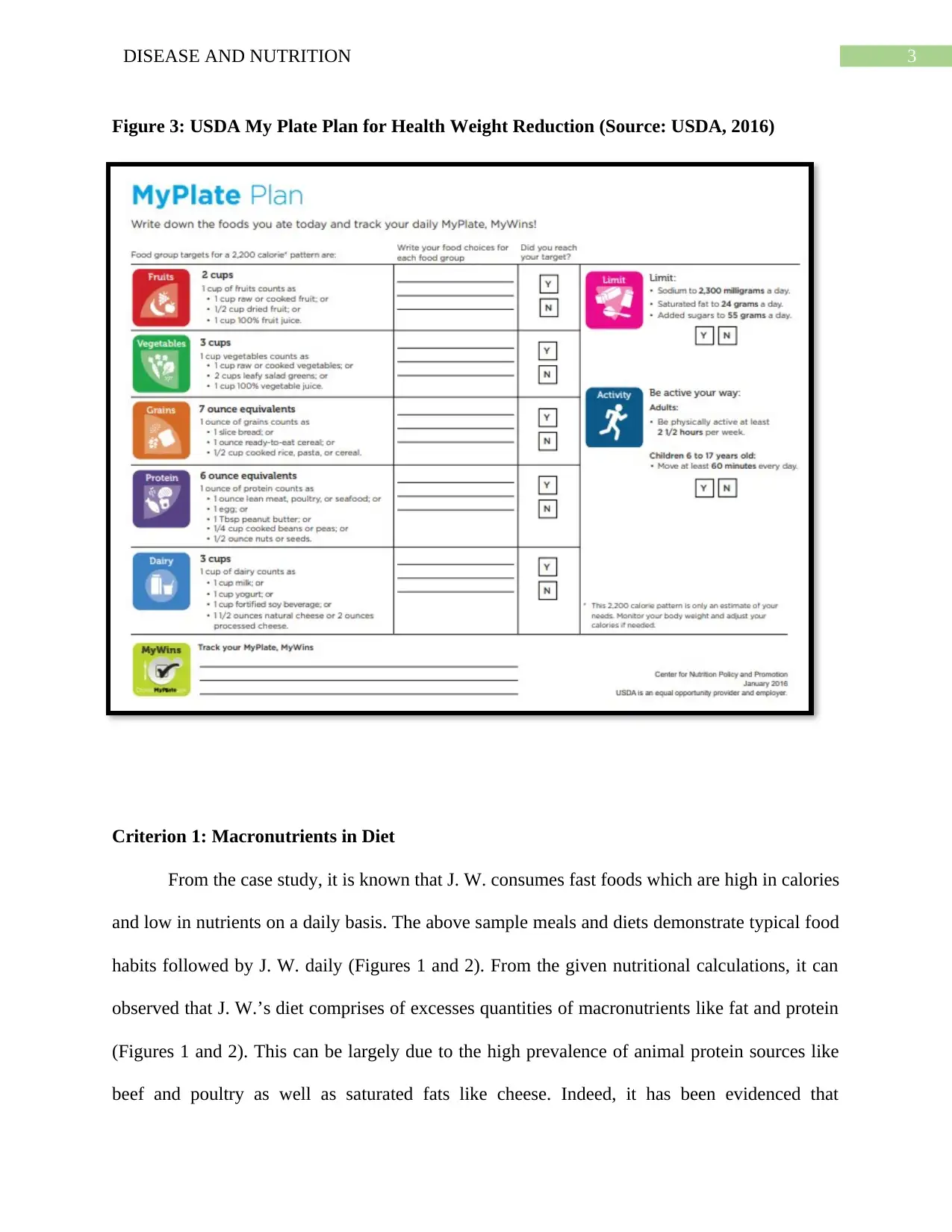
3DISEASE AND NUTRITION
Figure 3: USDA My Plate Plan for Health Weight Reduction (Source: USDA, 2016)
Criterion 1: Macronutrients in Diet
From the case study, it is known that J. W. consumes fast foods which are high in calories
and low in nutrients on a daily basis. The above sample meals and diets demonstrate typical food
habits followed by J. W. daily (Figures 1 and 2). From the given nutritional calculations, it can
observed that J. W.’s diet comprises of excesses quantities of macronutrients like fat and protein
(Figures 1 and 2). This can be largely due to the high prevalence of animal protein sources like
beef and poultry as well as saturated fats like cheese. Indeed, it has been evidenced that
Figure 3: USDA My Plate Plan for Health Weight Reduction (Source: USDA, 2016)
Criterion 1: Macronutrients in Diet
From the case study, it is known that J. W. consumes fast foods which are high in calories
and low in nutrients on a daily basis. The above sample meals and diets demonstrate typical food
habits followed by J. W. daily (Figures 1 and 2). From the given nutritional calculations, it can
observed that J. W.’s diet comprises of excesses quantities of macronutrients like fat and protein
(Figures 1 and 2). This can be largely due to the high prevalence of animal protein sources like
beef and poultry as well as saturated fats like cheese. Indeed, it has been evidenced that
Secure Best Marks with AI Grader
Need help grading? Try our AI Grader for instant feedback on your assignments.
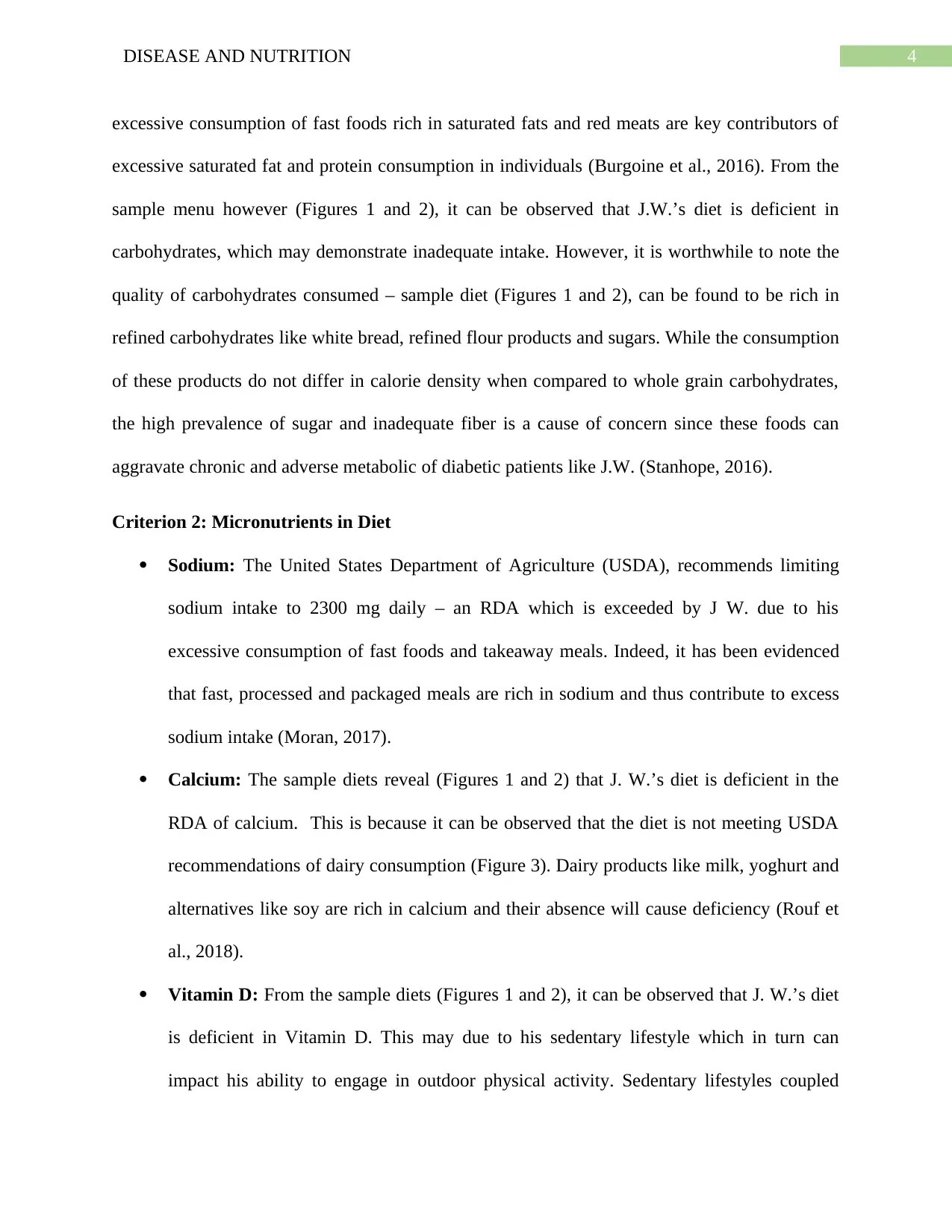
4DISEASE AND NUTRITION
excessive consumption of fast foods rich in saturated fats and red meats are key contributors of
excessive saturated fat and protein consumption in individuals (Burgoine et al., 2016). From the
sample menu however (Figures 1 and 2), it can be observed that J.W.’s diet is deficient in
carbohydrates, which may demonstrate inadequate intake. However, it is worthwhile to note the
quality of carbohydrates consumed – sample diet (Figures 1 and 2), can be found to be rich in
refined carbohydrates like white bread, refined flour products and sugars. While the consumption
of these products do not differ in calorie density when compared to whole grain carbohydrates,
the high prevalence of sugar and inadequate fiber is a cause of concern since these foods can
aggravate chronic and adverse metabolic of diabetic patients like J.W. (Stanhope, 2016).
Criterion 2: Micronutrients in Diet
Sodium: The United States Department of Agriculture (USDA), recommends limiting
sodium intake to 2300 mg daily – an RDA which is exceeded by J W. due to his
excessive consumption of fast foods and takeaway meals. Indeed, it has been evidenced
that fast, processed and packaged meals are rich in sodium and thus contribute to excess
sodium intake (Moran, 2017).
Calcium: The sample diets reveal (Figures 1 and 2) that J. W.’s diet is deficient in the
RDA of calcium. This is because it can be observed that the diet is not meeting USDA
recommendations of dairy consumption (Figure 3). Dairy products like milk, yoghurt and
alternatives like soy are rich in calcium and their absence will cause deficiency (Rouf et
al., 2018).
Vitamin D: From the sample diets (Figures 1 and 2), it can be observed that J. W.’s diet
is deficient in Vitamin D. This may due to his sedentary lifestyle which in turn can
impact his ability to engage in outdoor physical activity. Sedentary lifestyles coupled
excessive consumption of fast foods rich in saturated fats and red meats are key contributors of
excessive saturated fat and protein consumption in individuals (Burgoine et al., 2016). From the
sample menu however (Figures 1 and 2), it can be observed that J.W.’s diet is deficient in
carbohydrates, which may demonstrate inadequate intake. However, it is worthwhile to note the
quality of carbohydrates consumed – sample diet (Figures 1 and 2), can be found to be rich in
refined carbohydrates like white bread, refined flour products and sugars. While the consumption
of these products do not differ in calorie density when compared to whole grain carbohydrates,
the high prevalence of sugar and inadequate fiber is a cause of concern since these foods can
aggravate chronic and adverse metabolic of diabetic patients like J.W. (Stanhope, 2016).
Criterion 2: Micronutrients in Diet
Sodium: The United States Department of Agriculture (USDA), recommends limiting
sodium intake to 2300 mg daily – an RDA which is exceeded by J W. due to his
excessive consumption of fast foods and takeaway meals. Indeed, it has been evidenced
that fast, processed and packaged meals are rich in sodium and thus contribute to excess
sodium intake (Moran, 2017).
Calcium: The sample diets reveal (Figures 1 and 2) that J. W.’s diet is deficient in the
RDA of calcium. This is because it can be observed that the diet is not meeting USDA
recommendations of dairy consumption (Figure 3). Dairy products like milk, yoghurt and
alternatives like soy are rich in calcium and their absence will cause deficiency (Rouf et
al., 2018).
Vitamin D: From the sample diets (Figures 1 and 2), it can be observed that J. W.’s diet
is deficient in Vitamin D. This may due to his sedentary lifestyle which in turn can
impact his ability to engage in outdoor physical activity. Sedentary lifestyles coupled
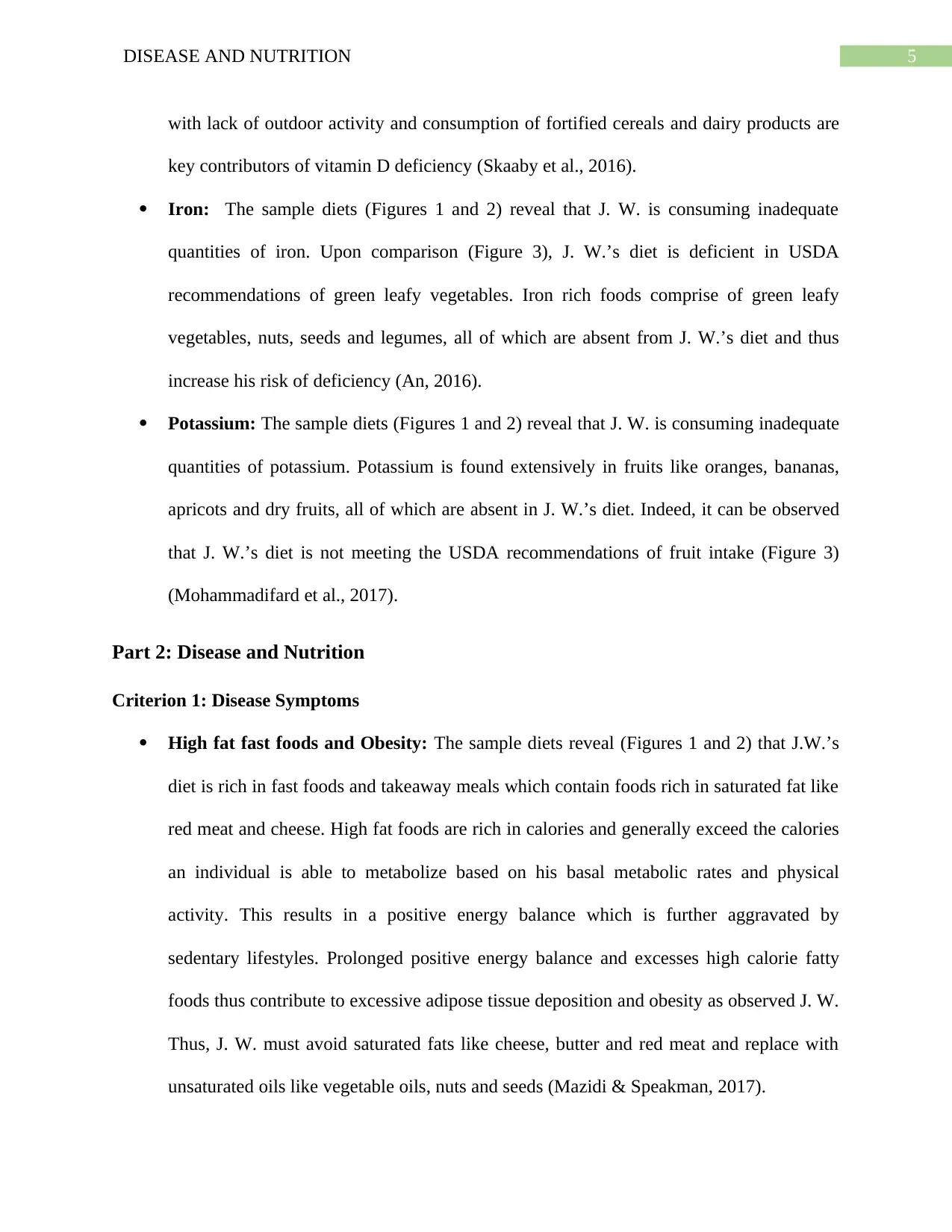
5DISEASE AND NUTRITION
with lack of outdoor activity and consumption of fortified cereals and dairy products are
key contributors of vitamin D deficiency (Skaaby et al., 2016).
Iron: The sample diets (Figures 1 and 2) reveal that J. W. is consuming inadequate
quantities of iron. Upon comparison (Figure 3), J. W.’s diet is deficient in USDA
recommendations of green leafy vegetables. Iron rich foods comprise of green leafy
vegetables, nuts, seeds and legumes, all of which are absent from J. W.’s diet and thus
increase his risk of deficiency (An, 2016).
Potassium: The sample diets (Figures 1 and 2) reveal that J. W. is consuming inadequate
quantities of potassium. Potassium is found extensively in fruits like oranges, bananas,
apricots and dry fruits, all of which are absent in J. W.’s diet. Indeed, it can be observed
that J. W.’s diet is not meeting the USDA recommendations of fruit intake (Figure 3)
(Mohammadifard et al., 2017).
Part 2: Disease and Nutrition
Criterion 1: Disease Symptoms
High fat fast foods and Obesity: The sample diets reveal (Figures 1 and 2) that J.W.’s
diet is rich in fast foods and takeaway meals which contain foods rich in saturated fat like
red meat and cheese. High fat foods are rich in calories and generally exceed the calories
an individual is able to metabolize based on his basal metabolic rates and physical
activity. This results in a positive energy balance which is further aggravated by
sedentary lifestyles. Prolonged positive energy balance and excesses high calorie fatty
foods thus contribute to excessive adipose tissue deposition and obesity as observed J. W.
Thus, J. W. must avoid saturated fats like cheese, butter and red meat and replace with
unsaturated oils like vegetable oils, nuts and seeds (Mazidi & Speakman, 2017).
with lack of outdoor activity and consumption of fortified cereals and dairy products are
key contributors of vitamin D deficiency (Skaaby et al., 2016).
Iron: The sample diets (Figures 1 and 2) reveal that J. W. is consuming inadequate
quantities of iron. Upon comparison (Figure 3), J. W.’s diet is deficient in USDA
recommendations of green leafy vegetables. Iron rich foods comprise of green leafy
vegetables, nuts, seeds and legumes, all of which are absent from J. W.’s diet and thus
increase his risk of deficiency (An, 2016).
Potassium: The sample diets (Figures 1 and 2) reveal that J. W. is consuming inadequate
quantities of potassium. Potassium is found extensively in fruits like oranges, bananas,
apricots and dry fruits, all of which are absent in J. W.’s diet. Indeed, it can be observed
that J. W.’s diet is not meeting the USDA recommendations of fruit intake (Figure 3)
(Mohammadifard et al., 2017).
Part 2: Disease and Nutrition
Criterion 1: Disease Symptoms
High fat fast foods and Obesity: The sample diets reveal (Figures 1 and 2) that J.W.’s
diet is rich in fast foods and takeaway meals which contain foods rich in saturated fat like
red meat and cheese. High fat foods are rich in calories and generally exceed the calories
an individual is able to metabolize based on his basal metabolic rates and physical
activity. This results in a positive energy balance which is further aggravated by
sedentary lifestyles. Prolonged positive energy balance and excesses high calorie fatty
foods thus contribute to excessive adipose tissue deposition and obesity as observed J. W.
Thus, J. W. must avoid saturated fats like cheese, butter and red meat and replace with
unsaturated oils like vegetable oils, nuts and seeds (Mazidi & Speakman, 2017).
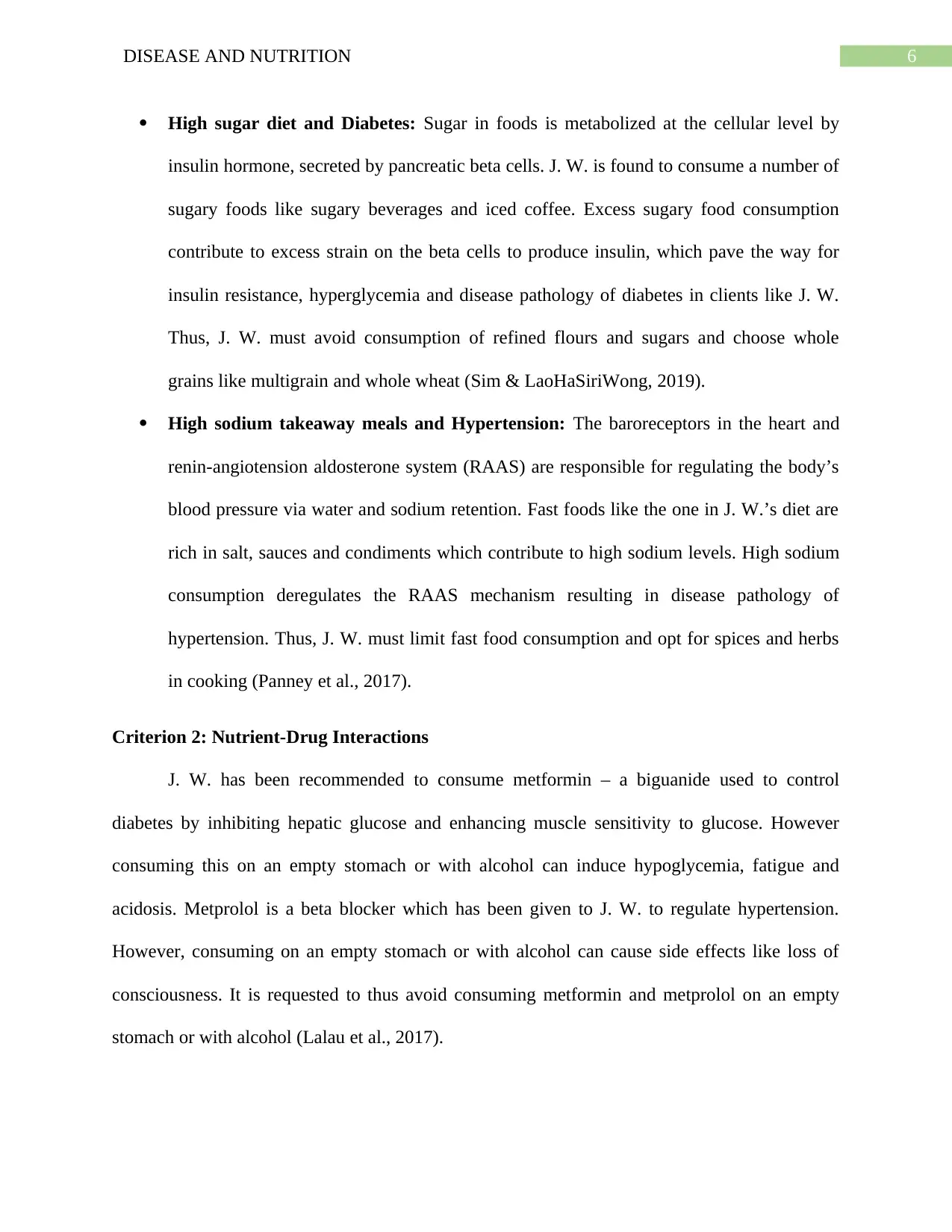
6DISEASE AND NUTRITION
High sugar diet and Diabetes: Sugar in foods is metabolized at the cellular level by
insulin hormone, secreted by pancreatic beta cells. J. W. is found to consume a number of
sugary foods like sugary beverages and iced coffee. Excess sugary food consumption
contribute to excess strain on the beta cells to produce insulin, which pave the way for
insulin resistance, hyperglycemia and disease pathology of diabetes in clients like J. W.
Thus, J. W. must avoid consumption of refined flours and sugars and choose whole
grains like multigrain and whole wheat (Sim & LaoHaSiriWong, 2019).
High sodium takeaway meals and Hypertension: The baroreceptors in the heart and
renin-angiotension aldosterone system (RAAS) are responsible for regulating the body’s
blood pressure via water and sodium retention. Fast foods like the one in J. W.’s diet are
rich in salt, sauces and condiments which contribute to high sodium levels. High sodium
consumption deregulates the RAAS mechanism resulting in disease pathology of
hypertension. Thus, J. W. must limit fast food consumption and opt for spices and herbs
in cooking (Panney et al., 2017).
Criterion 2: Nutrient-Drug Interactions
J. W. has been recommended to consume metformin – a biguanide used to control
diabetes by inhibiting hepatic glucose and enhancing muscle sensitivity to glucose. However
consuming this on an empty stomach or with alcohol can induce hypoglycemia, fatigue and
acidosis. Metprolol is a beta blocker which has been given to J. W. to regulate hypertension.
However, consuming on an empty stomach or with alcohol can cause side effects like loss of
consciousness. It is requested to thus avoid consuming metformin and metprolol on an empty
stomach or with alcohol (Lalau et al., 2017).
High sugar diet and Diabetes: Sugar in foods is metabolized at the cellular level by
insulin hormone, secreted by pancreatic beta cells. J. W. is found to consume a number of
sugary foods like sugary beverages and iced coffee. Excess sugary food consumption
contribute to excess strain on the beta cells to produce insulin, which pave the way for
insulin resistance, hyperglycemia and disease pathology of diabetes in clients like J. W.
Thus, J. W. must avoid consumption of refined flours and sugars and choose whole
grains like multigrain and whole wheat (Sim & LaoHaSiriWong, 2019).
High sodium takeaway meals and Hypertension: The baroreceptors in the heart and
renin-angiotension aldosterone system (RAAS) are responsible for regulating the body’s
blood pressure via water and sodium retention. Fast foods like the one in J. W.’s diet are
rich in salt, sauces and condiments which contribute to high sodium levels. High sodium
consumption deregulates the RAAS mechanism resulting in disease pathology of
hypertension. Thus, J. W. must limit fast food consumption and opt for spices and herbs
in cooking (Panney et al., 2017).
Criterion 2: Nutrient-Drug Interactions
J. W. has been recommended to consume metformin – a biguanide used to control
diabetes by inhibiting hepatic glucose and enhancing muscle sensitivity to glucose. However
consuming this on an empty stomach or with alcohol can induce hypoglycemia, fatigue and
acidosis. Metprolol is a beta blocker which has been given to J. W. to regulate hypertension.
However, consuming on an empty stomach or with alcohol can cause side effects like loss of
consciousness. It is requested to thus avoid consuming metformin and metprolol on an empty
stomach or with alcohol (Lalau et al., 2017).
Paraphrase This Document
Need a fresh take? Get an instant paraphrase of this document with our AI Paraphraser
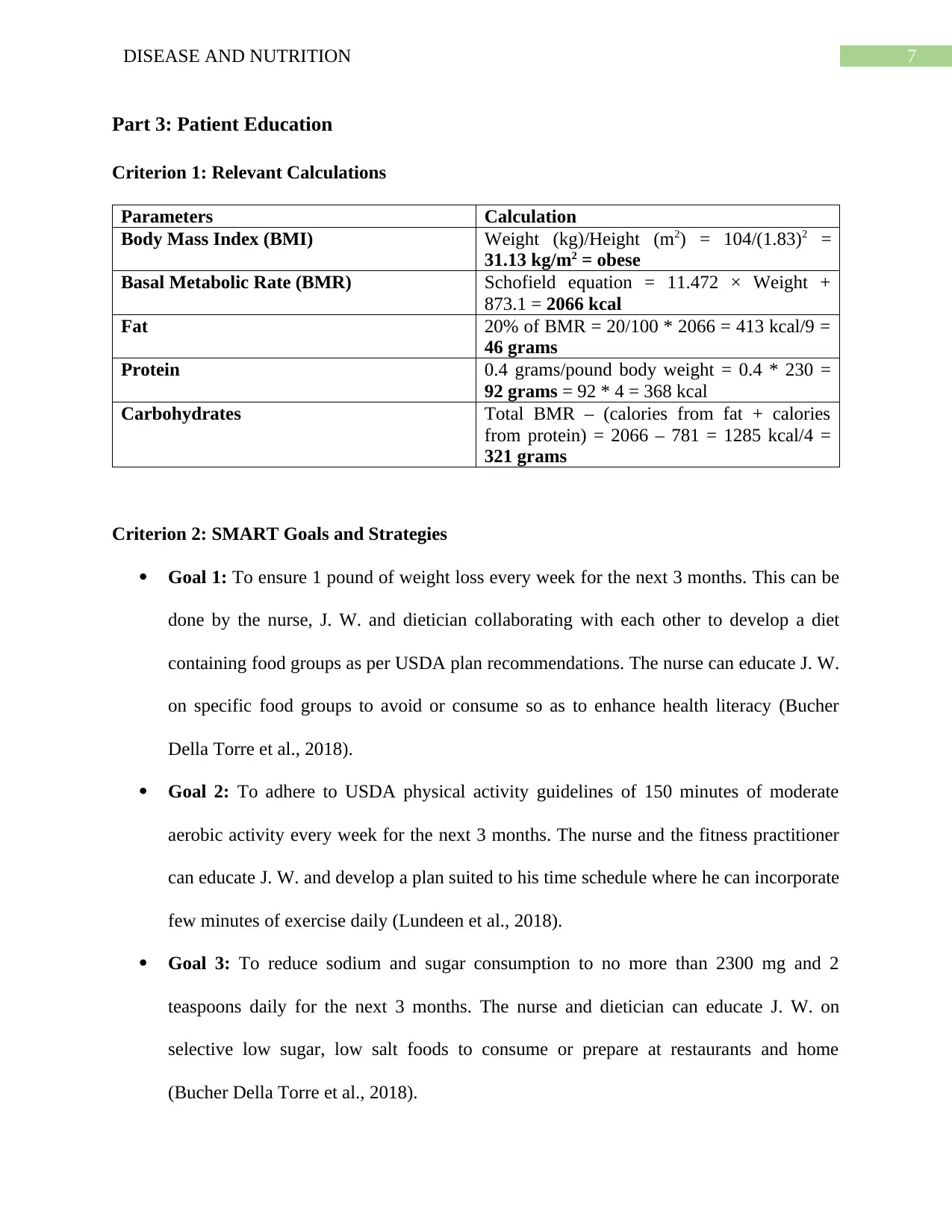
7DISEASE AND NUTRITION
Part 3: Patient Education
Criterion 1: Relevant Calculations
Parameters Calculation
Body Mass Index (BMI) Weight (kg)/Height (m2) = 104/(1.83)2 =
31.13 kg/m2 = obese
Basal Metabolic Rate (BMR) Schofield equation = 11.472 × Weight +
873.1 = 2066 kcal
Fat 20% of BMR = 20/100 * 2066 = 413 kcal/9 =
46 grams
Protein 0.4 grams/pound body weight = 0.4 * 230 =
92 grams = 92 * 4 = 368 kcal
Carbohydrates Total BMR – (calories from fat + calories
from protein) = 2066 – 781 = 1285 kcal/4 =
321 grams
Criterion 2: SMART Goals and Strategies
Goal 1: To ensure 1 pound of weight loss every week for the next 3 months. This can be
done by the nurse, J. W. and dietician collaborating with each other to develop a diet
containing food groups as per USDA plan recommendations. The nurse can educate J. W.
on specific food groups to avoid or consume so as to enhance health literacy (Bucher
Della Torre et al., 2018).
Goal 2: To adhere to USDA physical activity guidelines of 150 minutes of moderate
aerobic activity every week for the next 3 months. The nurse and the fitness practitioner
can educate J. W. and develop a plan suited to his time schedule where he can incorporate
few minutes of exercise daily (Lundeen et al., 2018).
Goal 3: To reduce sodium and sugar consumption to no more than 2300 mg and 2
teaspoons daily for the next 3 months. The nurse and dietician can educate J. W. on
selective low sugar, low salt foods to consume or prepare at restaurants and home
(Bucher Della Torre et al., 2018).
Part 3: Patient Education
Criterion 1: Relevant Calculations
Parameters Calculation
Body Mass Index (BMI) Weight (kg)/Height (m2) = 104/(1.83)2 =
31.13 kg/m2 = obese
Basal Metabolic Rate (BMR) Schofield equation = 11.472 × Weight +
873.1 = 2066 kcal
Fat 20% of BMR = 20/100 * 2066 = 413 kcal/9 =
46 grams
Protein 0.4 grams/pound body weight = 0.4 * 230 =
92 grams = 92 * 4 = 368 kcal
Carbohydrates Total BMR – (calories from fat + calories
from protein) = 2066 – 781 = 1285 kcal/4 =
321 grams
Criterion 2: SMART Goals and Strategies
Goal 1: To ensure 1 pound of weight loss every week for the next 3 months. This can be
done by the nurse, J. W. and dietician collaborating with each other to develop a diet
containing food groups as per USDA plan recommendations. The nurse can educate J. W.
on specific food groups to avoid or consume so as to enhance health literacy (Bucher
Della Torre et al., 2018).
Goal 2: To adhere to USDA physical activity guidelines of 150 minutes of moderate
aerobic activity every week for the next 3 months. The nurse and the fitness practitioner
can educate J. W. and develop a plan suited to his time schedule where he can incorporate
few minutes of exercise daily (Lundeen et al., 2018).
Goal 3: To reduce sodium and sugar consumption to no more than 2300 mg and 2
teaspoons daily for the next 3 months. The nurse and dietician can educate J. W. on
selective low sugar, low salt foods to consume or prepare at restaurants and home
(Bucher Della Torre et al., 2018).
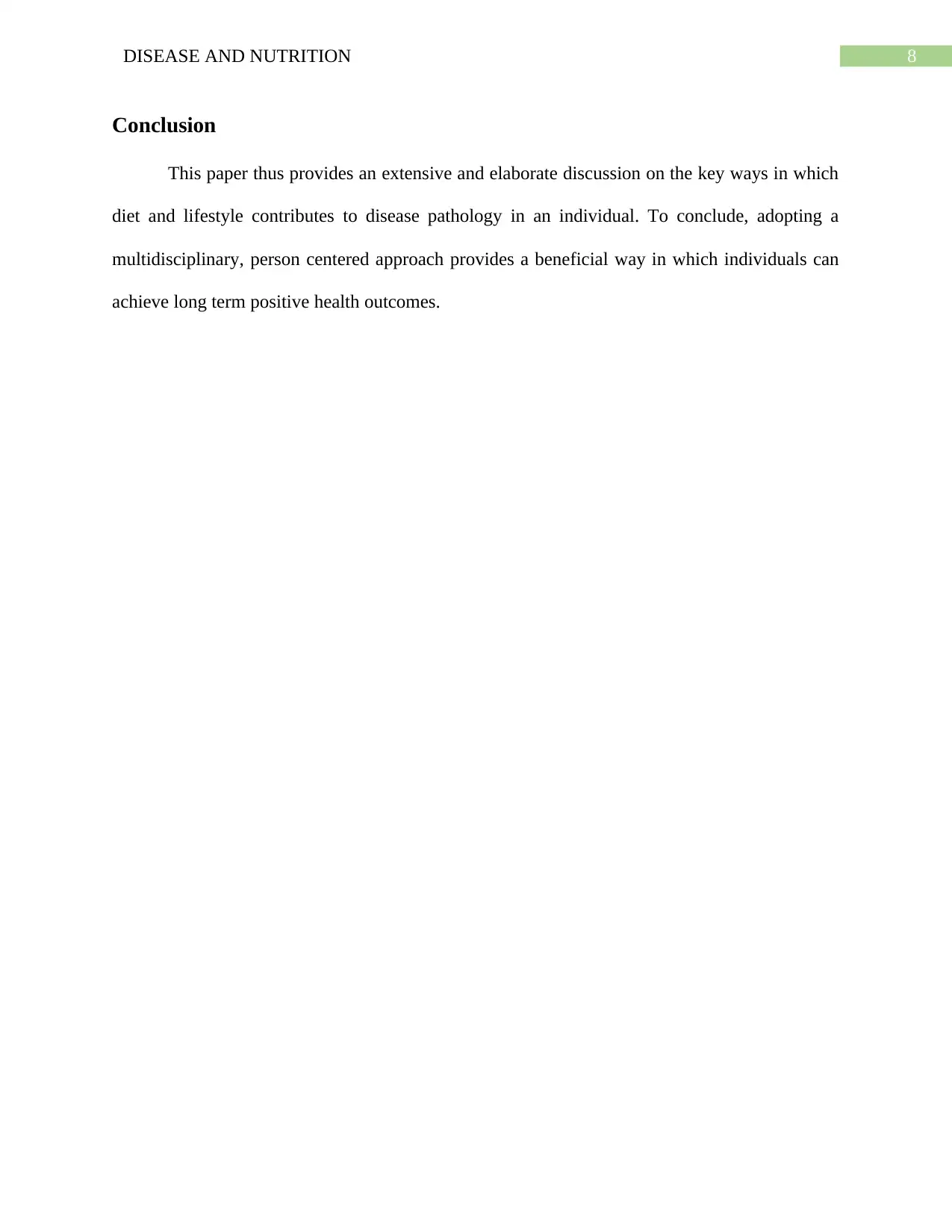
8DISEASE AND NUTRITION
Conclusion
This paper thus provides an extensive and elaborate discussion on the key ways in which
diet and lifestyle contributes to disease pathology in an individual. To conclude, adopting a
multidisciplinary, person centered approach provides a beneficial way in which individuals can
achieve long term positive health outcomes.
Conclusion
This paper thus provides an extensive and elaborate discussion on the key ways in which
diet and lifestyle contributes to disease pathology in an individual. To conclude, adopting a
multidisciplinary, person centered approach provides a beneficial way in which individuals can
achieve long term positive health outcomes.
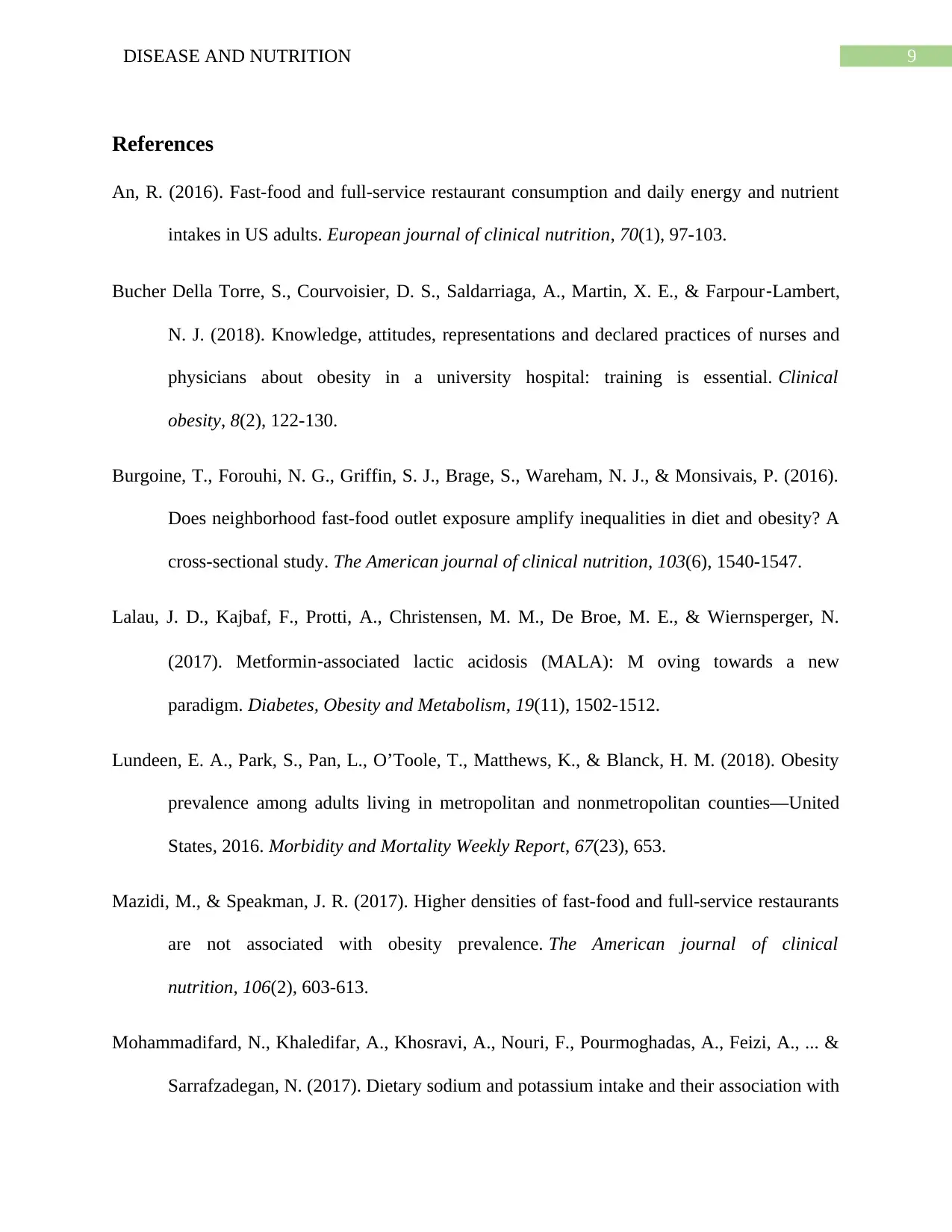
9DISEASE AND NUTRITION
References
An, R. (2016). Fast-food and full-service restaurant consumption and daily energy and nutrient
intakes in US adults. European journal of clinical nutrition, 70(1), 97-103.
Bucher Della Torre, S., Courvoisier, D. S., Saldarriaga, A., Martin, X. E., & Farpour‐Lambert,
N. J. (2018). Knowledge, attitudes, representations and declared practices of nurses and
physicians about obesity in a university hospital: training is essential. Clinical
obesity, 8(2), 122-130.
Burgoine, T., Forouhi, N. G., Griffin, S. J., Brage, S., Wareham, N. J., & Monsivais, P. (2016).
Does neighborhood fast-food outlet exposure amplify inequalities in diet and obesity? A
cross-sectional study. The American journal of clinical nutrition, 103(6), 1540-1547.
Lalau, J. D., Kajbaf, F., Protti, A., Christensen, M. M., De Broe, M. E., & Wiernsperger, N.
(2017). Metformin‐associated lactic acidosis (MALA): M oving towards a new
paradigm. Diabetes, Obesity and Metabolism, 19(11), 1502-1512.
Lundeen, E. A., Park, S., Pan, L., O’Toole, T., Matthews, K., & Blanck, H. M. (2018). Obesity
prevalence among adults living in metropolitan and nonmetropolitan counties—United
States, 2016. Morbidity and Mortality Weekly Report, 67(23), 653.
Mazidi, M., & Speakman, J. R. (2017). Higher densities of fast-food and full-service restaurants
are not associated with obesity prevalence. The American journal of clinical
nutrition, 106(2), 603-613.
Mohammadifard, N., Khaledifar, A., Khosravi, A., Nouri, F., Pourmoghadas, A., Feizi, A., ... &
Sarrafzadegan, N. (2017). Dietary sodium and potassium intake and their association with
References
An, R. (2016). Fast-food and full-service restaurant consumption and daily energy and nutrient
intakes in US adults. European journal of clinical nutrition, 70(1), 97-103.
Bucher Della Torre, S., Courvoisier, D. S., Saldarriaga, A., Martin, X. E., & Farpour‐Lambert,
N. J. (2018). Knowledge, attitudes, representations and declared practices of nurses and
physicians about obesity in a university hospital: training is essential. Clinical
obesity, 8(2), 122-130.
Burgoine, T., Forouhi, N. G., Griffin, S. J., Brage, S., Wareham, N. J., & Monsivais, P. (2016).
Does neighborhood fast-food outlet exposure amplify inequalities in diet and obesity? A
cross-sectional study. The American journal of clinical nutrition, 103(6), 1540-1547.
Lalau, J. D., Kajbaf, F., Protti, A., Christensen, M. M., De Broe, M. E., & Wiernsperger, N.
(2017). Metformin‐associated lactic acidosis (MALA): M oving towards a new
paradigm. Diabetes, Obesity and Metabolism, 19(11), 1502-1512.
Lundeen, E. A., Park, S., Pan, L., O’Toole, T., Matthews, K., & Blanck, H. M. (2018). Obesity
prevalence among adults living in metropolitan and nonmetropolitan counties—United
States, 2016. Morbidity and Mortality Weekly Report, 67(23), 653.
Mazidi, M., & Speakman, J. R. (2017). Higher densities of fast-food and full-service restaurants
are not associated with obesity prevalence. The American journal of clinical
nutrition, 106(2), 603-613.
Mohammadifard, N., Khaledifar, A., Khosravi, A., Nouri, F., Pourmoghadas, A., Feizi, A., ... &
Sarrafzadegan, N. (2017). Dietary sodium and potassium intake and their association with
Secure Best Marks with AI Grader
Need help grading? Try our AI Grader for instant feedback on your assignments.
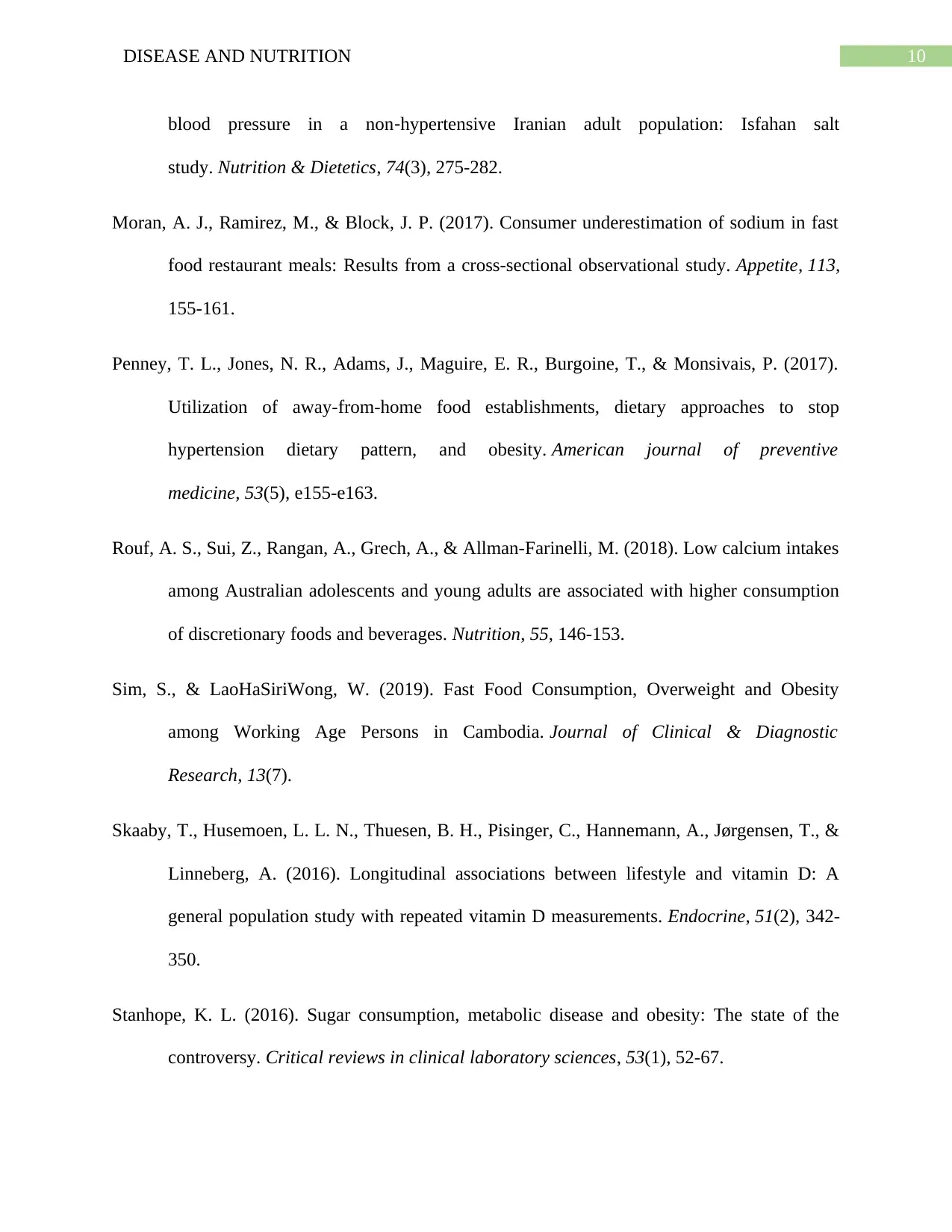
10DISEASE AND NUTRITION
blood pressure in a non‐hypertensive Iranian adult population: Isfahan salt
study. Nutrition & Dietetics, 74(3), 275-282.
Moran, A. J., Ramirez, M., & Block, J. P. (2017). Consumer underestimation of sodium in fast
food restaurant meals: Results from a cross-sectional observational study. Appetite, 113,
155-161.
Penney, T. L., Jones, N. R., Adams, J., Maguire, E. R., Burgoine, T., & Monsivais, P. (2017).
Utilization of away-from-home food establishments, dietary approaches to stop
hypertension dietary pattern, and obesity. American journal of preventive
medicine, 53(5), e155-e163.
Rouf, A. S., Sui, Z., Rangan, A., Grech, A., & Allman-Farinelli, M. (2018). Low calcium intakes
among Australian adolescents and young adults are associated with higher consumption
of discretionary foods and beverages. Nutrition, 55, 146-153.
Sim, S., & LaoHaSiriWong, W. (2019). Fast Food Consumption, Overweight and Obesity
among Working Age Persons in Cambodia. Journal of Clinical & Diagnostic
Research, 13(7).
Skaaby, T., Husemoen, L. L. N., Thuesen, B. H., Pisinger, C., Hannemann, A., Jørgensen, T., &
Linneberg, A. (2016). Longitudinal associations between lifestyle and vitamin D: A
general population study with repeated vitamin D measurements. Endocrine, 51(2), 342-
350.
Stanhope, K. L. (2016). Sugar consumption, metabolic disease and obesity: The state of the
controversy. Critical reviews in clinical laboratory sciences, 53(1), 52-67.
blood pressure in a non‐hypertensive Iranian adult population: Isfahan salt
study. Nutrition & Dietetics, 74(3), 275-282.
Moran, A. J., Ramirez, M., & Block, J. P. (2017). Consumer underestimation of sodium in fast
food restaurant meals: Results from a cross-sectional observational study. Appetite, 113,
155-161.
Penney, T. L., Jones, N. R., Adams, J., Maguire, E. R., Burgoine, T., & Monsivais, P. (2017).
Utilization of away-from-home food establishments, dietary approaches to stop
hypertension dietary pattern, and obesity. American journal of preventive
medicine, 53(5), e155-e163.
Rouf, A. S., Sui, Z., Rangan, A., Grech, A., & Allman-Farinelli, M. (2018). Low calcium intakes
among Australian adolescents and young adults are associated with higher consumption
of discretionary foods and beverages. Nutrition, 55, 146-153.
Sim, S., & LaoHaSiriWong, W. (2019). Fast Food Consumption, Overweight and Obesity
among Working Age Persons in Cambodia. Journal of Clinical & Diagnostic
Research, 13(7).
Skaaby, T., Husemoen, L. L. N., Thuesen, B. H., Pisinger, C., Hannemann, A., Jørgensen, T., &
Linneberg, A. (2016). Longitudinal associations between lifestyle and vitamin D: A
general population study with repeated vitamin D measurements. Endocrine, 51(2), 342-
350.
Stanhope, K. L. (2016). Sugar consumption, metabolic disease and obesity: The state of the
controversy. Critical reviews in clinical laboratory sciences, 53(1), 52-67.

11DISEASE AND NUTRITION
USDA. (2016). My Plate Plan. Retrieved 27 March 2020, from https://choosemyplate-
prod.azureedge.net/sites/default/files/myplate/checklists/
MyPlatePlan_2200cals_Age14plus.pdf.
USDA. (2016). My Plate Plan. Retrieved 27 March 2020, from https://choosemyplate-
prod.azureedge.net/sites/default/files/myplate/checklists/
MyPlatePlan_2200cals_Age14plus.pdf.
1 out of 12
Related Documents
Your All-in-One AI-Powered Toolkit for Academic Success.
+13062052269
info@desklib.com
Available 24*7 on WhatsApp / Email
![[object Object]](/_next/static/media/star-bottom.7253800d.svg)
Unlock your academic potential
© 2024 | Zucol Services PVT LTD | All rights reserved.





